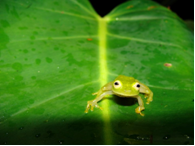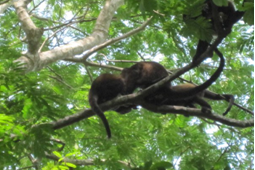Posted: November 3, 2011
For one month, June 2011, I traveled abroad, meeting and working with people from all over the world who shared at least one thing in common: a passion for conservation.
With Operation Wallacea (Opwall), twenty eight students and I went to Honduras. We came from the UK, Canada, the US, Greece, Poland, France, and Ireland and immediately enjoyed learning from each other about our many similarities and differences.
Week one was jungle training week which included class on topics related to the projects to be done, methods of research, and the history of Opwall's involvement in conservation research in Cusuco National Park, Honduras. We also spent three days and three nights in the jungle, setting up our own hammocks, rationing and cooking our own food and getting to know one another in addition to the landscape. We were split up into smaller groups for this and assigned a group leader. I was given that position for my group of 7. The toughest part of this was physically getting used to the landscape and elevation, but we all did very well and enjoyed each others company tremendously.
 By week two, people were moving on to the various camps and some I would not see any more during my three remaining weeks. I stayed in base camp on the east side of the mountain with a handful of people. I was scheduled to take a DNA course where we were to create a gel via electrophoresis of plant DNA that we collected and then take another plant of the same species and determine if they shared a parent plant. All three samples in my class failed, but we still learned the methods involved and got a chance to practice. Class and lab didn't take up the entire day so in my free time I went out with the birding team in the afternoon or the bat team at night doing mist netting. By the end of the week I was ready to move on to a new camp with more opportunities for projects.
By week two, people were moving on to the various camps and some I would not see any more during my three remaining weeks. I stayed in base camp on the east side of the mountain with a handful of people. I was scheduled to take a DNA course where we were to create a gel via electrophoresis of plant DNA that we collected and then take another plant of the same species and determine if they shared a parent plant. All three samples in my class failed, but we still learned the methods involved and got a chance to practice. Class and lab didn't take up the entire day so in my free time I went out with the birding team in the afternoon or the bat team at night doing mist netting. By the end of the week I was ready to move on to a new camp with more opportunities for projects.
Weeks 3 and 4 were my favorite. In week three I traveled down the mountain and into the town of Cofradia. It was there that I interacted the most with the Honduran people and learned about the culture and way of life. The research I was helping with this week was part of an on-going Howler Monkey behavioral study. There are seven populations of Howlers on seven small fragments of land that are getting smaller each year. We are seeing if being in such a limited space has affected their behavior towards each other and their territorial behavior. Spending a week so close to these animals, watching their every move for six hours a day was incredible.
 My final week I spent in a small mountainside village know as Santo Thomas on the west side of the mountain, located in the buffer zone of Cusuco National Park. I went birding in the morning and also went on herp walks, both to get a biodiversity survey of the species in the area. I also went to opportunistic bird walks and opportunistic herp walks when they occurred. I especially loved working with the bird team at this camp and spent the 4th of July birding for 10 hours, returning to camp drenched from the pouring rain. That was by far my favorite day of the entire month.
My final week I spent in a small mountainside village know as Santo Thomas on the west side of the mountain, located in the buffer zone of Cusuco National Park. I went birding in the morning and also went on herp walks, both to get a biodiversity survey of the species in the area. I also went to opportunistic bird walks and opportunistic herp walks when they occurred. I especially loved working with the bird team at this camp and spent the 4th of July birding for 10 hours, returning to camp drenched from the pouring rain. That was by far my favorite day of the entire month.
Ag Sciences Global
Address
106 Agricultural Administration BuildingUniversity Park, PA 16802
- Email globalag@psu.edu
- Office 814-863-0249
- Fax 814-865-3055
Ag Sciences Global
Address
106 Agricultural Administration BuildingUniversity Park, PA 16802
- Email globalag@psu.edu
- Office 814-863-0249
- Fax 814-865-3055


